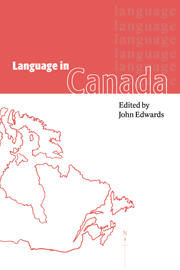Book contents
- Frontmatter
- Contents
- List of figures
- List of maps
- List of tables
- Notes on contributors
- 1 Canada
- Introduction
- 1 The foundations
- 2 The fading Canadian duality
- 3 Official bilingualism: from the 1960s to the 1990s
- 4 Official multiculturalism
- 5 Language in education: bridging educational policy and social psychological research
- 6 Aboriginal languages: history
- 7 Aboriginal languages: current status
- 8 French: Canadian varieties
- 9 French in Quebec
- 10 French in New Brunswick
- 11 French outside New Brunswick and Quebec
- 12 English: Canadian varieties
- 13 English Quebec
- 14 The teaching of international languages
- 15 French immersion in Canada
- 16 Language in Newfoundland
- 17 Language in Prince Edward Island
- 18 Language in Nova Scotia
- 19 Language in New Brunswick
- 20 Language in Quebec: aboriginal and heritage varieties
- 21 Language in Ontario
- 22 Language in Manitoba
- 23 Language in Saskatchewan: Anglo-hegemony maintained
- 24 Language in Alberta: unilingualism in practice
- 25 Language in British Columbia
- 26 Language in the Northwest Territories and the Yukon Territory
- Index of names
- Index of language families, languages, dialects
- Index of subjects
23 - Language in Saskatchewan: Anglo-hegemony maintained
Published online by Cambridge University Press: 18 February 2010
- Frontmatter
- Contents
- List of figures
- List of maps
- List of tables
- Notes on contributors
- 1 Canada
- Introduction
- 1 The foundations
- 2 The fading Canadian duality
- 3 Official bilingualism: from the 1960s to the 1990s
- 4 Official multiculturalism
- 5 Language in education: bridging educational policy and social psychological research
- 6 Aboriginal languages: history
- 7 Aboriginal languages: current status
- 8 French: Canadian varieties
- 9 French in Quebec
- 10 French in New Brunswick
- 11 French outside New Brunswick and Quebec
- 12 English: Canadian varieties
- 13 English Quebec
- 14 The teaching of international languages
- 15 French immersion in Canada
- 16 Language in Newfoundland
- 17 Language in Prince Edward Island
- 18 Language in Nova Scotia
- 19 Language in New Brunswick
- 20 Language in Quebec: aboriginal and heritage varieties
- 21 Language in Ontario
- 22 Language in Manitoba
- 23 Language in Saskatchewan: Anglo-hegemony maintained
- 24 Language in Alberta: unilingualism in practice
- 25 Language in British Columbia
- 26 Language in the Northwest Territories and the Yukon Territory
- Index of names
- Index of language families, languages, dialects
- Index of subjects
Summary
INTRODUCTION
Saskatchewan's history and demography have dictated to a large extent that English should dominate and non-anglophones should assimilate to English. Different policies in earlier times could have created a different social reality, but history cannot be re-written. Saskatchewan's language policies appear quite varied over time; yet, for non-English groups, these policies – as in most of English Canada – share the common outcome of maintaining the dominance of English, in spite of protracted resistance by other language groups. Gramsci's (1971) concept of ideological hegemony (the manner by which a dominant class imposes its culture, ideology and world view on subordinate groups) provides a useful lens through which to analyse language policy and can be applied to Anglo-domination in English Canada. A full account of the mechanisms of Anglo-domination and minority-group responses would extend beyond the limits of this chapter, especially since the experiences of domination and resistance are different for aboriginal, French and immigrant groups. For all three, education is the major policy domain, but French has also been important in other areas. Minority-group struggles to maintain their language, identity and culture will remain in the background here as I focus on mechanisms of domination.
The study of a policy area must consider the combined impact of apparently unrelated laws which together form a particular legislative regime.
- Type
- Chapter
- Information
- Language in Canada , pp. 424 - 441Publisher: Cambridge University PressPrint publication year: 1998
- 3
- Cited by

